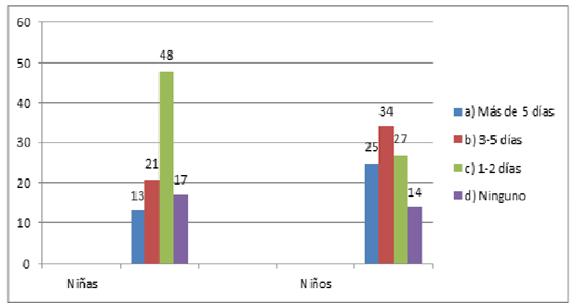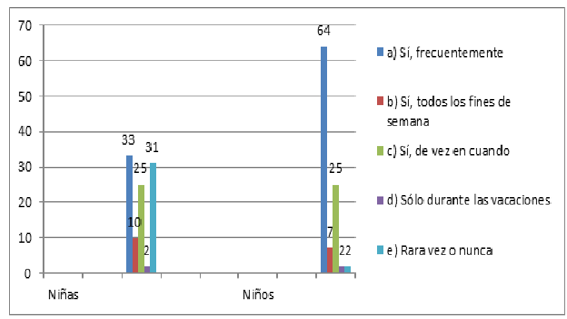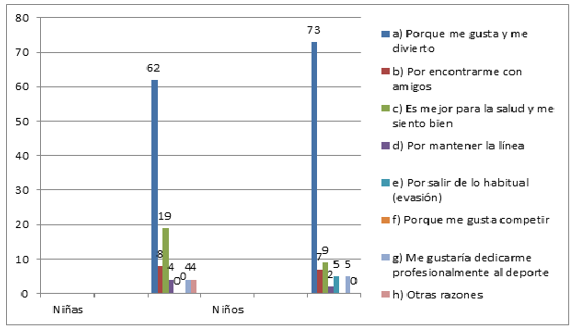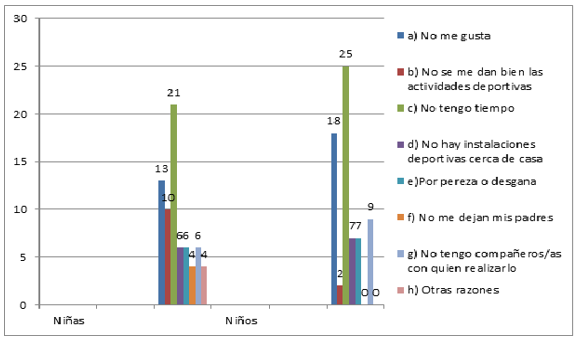My SciELO
Services on Demand
Journal
Article
Indicators
-
 Cited by SciELO
Cited by SciELO
Related links
-
 Similars in
SciELO
Similars in
SciELO
Share
Podium. Revista de Ciencia y Tecnología en la Cultura Física
On-line version ISSN 1996-2452
Rev Podium vol.15 no.2 Pinar del Río Mayo.-Aug. 2020 Epub Aug 01, 2020
Original article
Reasons and habits that affect the practice of physical activity in high school students
1Instituto Tecnológico de Sonora, México.
The practice of physical activity presumes numerous benefits by virtue of the way in which it is carried out, in addition to the purposes that are desired to achieve, based on the objectives to know and analyze, the reasons and habits with respect to the practice of physical activity in third grade students of a school in Obregon City, Sonora Mexico. The design of this research is mixed. A convenience sampling was used, which was conformed by 96 students of the third grade of high school; all of them with 14 years of age. The questionnaire "Yesterday Activity Cheklist" was used, adapted for young people from 10 to 16 years old, as well as documentary review and observation. Among the results obtained, the frequency with which girls perform physical activity is lower when compared to boys, which is low in both cases. The determining reason why they practice physical activity is because they like it and have fun, and an alarming fact is that part of the population does not practice physical activity due to lack of time and the greater percentage predominates in boys. Based on all these results, the aim is for teachers and parents to promote physical activity with their students and children in order to improve their quality of life.
Keywords: physical activity; purposes; reasons; habits; quality of life.
Introduction
Currently, young people in their leisure time, prefer among their daily activities to do those in which they remain in a passive way, much of the time, such as spending hours in front of the TV or video games, use of computers, use of cell phones, among others, and therefore are involved in the problem of sedentarism. In the past, children dedicated their free time to more active activities, of a competitive and/or recreational nature, in games and some sports. However, due to different circumstances, the habit has gradually been lost to the point of minimizing the effective time for practicing physical activity and sports. Nevertheless, Arufe et al., (2017) mention that many families enroll their children in sports, among other activities; therefore, time should be focused on the adolescent so that he or she can use it in activities that favor his or her integral development.
In accordance with the above, Barrigón (2017) states that,
"education, in free time, constitutes a set of processes, techniques and resources that are intended to raise people's awareness, in their good employment, to remain more active and contribute satisfactorily to society".
For this reason, Hernández et al., (2018) mention that physical activity applied to children should be through games that are recreational and attractive to them and thus obtain benefits that are significant in the long term.
The regular practice of physical activity is associated with a healthier and longer life, marked by various factors that influence it not to develop, such as the insecurity with which people live in the streets, the lack of places with green areas, technology, due to the lack of culture of movement, among others. Physical inactivity is well known by all that leads to different problems such as overweight, obesity and because of this chronic noncommunicable disease. Therefore, Pérez et al., (2017) confirm that unhealthy lifestyle habits lead to the promotion of pathologies and chronic diseases. In this sense, Pérez et al., (2015) state that the habitual practice of physical activity, combined with a good diet, and should constitute an essential habit in the life of any person.
Similarly, Ramos et al., (2016) argue that the habit of physical activity should be present in all people because it contributes to the prevention of many diseases, which generates physical, psychological and social benefits and is a key aspect of a healthy lifestyle. Without a doubt, one of the scenarios where students can be promoted, motivated and encouraged to find pleasure in the practice of physical activity and sports is in the Physical Education class, where students are encouraged to participate actively, making sense of each of the activities they do (González et al., 2017).
For a regular practice of physical activity, there are several aspects that determine the success of the activity to be developed; one of these is motivation. For this reason, Armenta (2015) comments that this should be, at first, oriented towards enjoyment, changing its meaning as age advances, until it is practiced with aspects related to health; enjoyment is a transcendental factor to explain the commitment and prediction of physical activity behaviours (Iturricastillo and Yanci, 2016). In this sense, Matarma et al., (2017) point out that there is evidence of the relationship between parents' lifestyles and children's lifestyles; therefore, it is essential to have a good posture in this area in order to determine, in a certain way, the actions that children will develop.
De Hoyo and Sañudo (2007) carried out a study that addresses the motives and practice habits of children between 12 and 16 years old, from a rural area of Seville. The results show that only 28 % of girls practice physical activity (PA) regularly, while boys represent 58 % who do so. Among the reasons that lead subjects to practice PA, we find that fun is the main reason in boys and girls, with 38 % and 31 % respectively; lack of time is the main reason that students argued for not practicing PA, with 24 % of boys and 28 % of girls.
For his part, Caro (2010) conducted research to determine the reasons for physical and sports practice by school-age students in Huelva. resulting in the greater frequency with which the subjects perform physical activity on a weekly basis; it was obtained that 74 % practice "three times or more per week" and 15 %, once or twice a week. Regarding the use of free time, it was found that "being with family and friends" is the activity to which more time is usually devoted. Among the reasons to practice physical activity, it was found that 89 % in "doing physical exercise", "maintain and/or improve my health" by 85 %, "like physical activity by 83 % or "fun and spend time" by 82 %.
Meanwhile, Pérez et al., (2017) carried out a study in which the objective was to find out about the physical activity habits of third cycle primary school students. A total of 136 5th and 6th grade students participated. Two questionnaires were used (WHO and PAQ-C) in which the frequency of practice, level of activation, and sports activities, among others, were evaluated. The results show that a higher percentage of them spend less than 2 hours in sedentary activities, with a low frequency of physical activity.
Knowing the reasons and habits for practicing physical activity will give us parameters to identify the population's health status and, in part, their quality of life.
For the above reasons, the following research question is posed: how does the application of a "Yesterday Activity Cheklist" questionnaire affect the motives and habits of physical activity practice in students in Ciudad Obregon, Sonora?
The objective of this research is to know and analyze the reasons and habits with respect to the practice of physical activity in third grade students of a school in Ciudad Obregon, Sonora, through the Yesterday Activity Checklist questionnaire to identify the opinions and interests of the students.
Materials and methods
The design of this research is mixed (qualitative-quantitative), qualitative because it uses data collection and analysis to reveal new questions in the process of interpretation and quantitative because it uses data collection based on numerical measurement and statistical analysis (Hernández et al., 2004).
The study population consisted of high school students from a school in Ciudad Obregon. For the selection of the sample, a convenience sampling was carried out, which is defined by Otzen and Manterola (2017) as that which allows the selection of accessible cases that accept to be included, according to their accessibility and proximity of the subjects to the researcher. The sex and age of the subjects were taken as a reference.
The sample was 96 subjects (n1= 44 boys, n2= 52 girls), enrolled in the third grade of high school, with 14 years of age. Among the reasons for the inclusion of the sample, it was taken into account that they were 14 years old students, belonging to the third grade of high school. As for the reasons for exclusion, we did not work with students who were outside the aforementioned age range and who did not belong to the same institution. The general characteristics of the study sample are presented in table 1 (Table 1).
Table 1 - General characteristics of the sample
| Sample (%) | Gender age | |
| 96 (100) | Male 44 (45.83) 14 (100) Female 52 (54.16) |
Among the variables of analysis of the present study, gender and age were considered, as well as the reasons and habits of physical activity practice.
The instrument used to find out the information referred to the motives and habits of physical activity practice was the survey published by Tercedor (1998), which is a translation of the "Yesterday Activity Checklist", created by Sallis et al., (1993) This was validated for ten-year-old children by Tercedor and López (1999) and later adapted by Casimiro (1999) for 12-16 year-olds. The instrument addresses four issues which are: practice of physical activity or sport outside of school hours; days of the week that they practice physical activity, of a certain intensity, outside of school hours; main reasons why they practice physical activity; main reasons why they do not practice physical activity.
The implementation of the instrument was carried out in a single step. Previously, the director and teachers of the educational institution in question gave authorization. The aforementioned survey was applied to the sample and the appropriate instructions were given for its correct completion; the estimated time to answer it was ten minutes.
Likewise, documentary review and observation were used to clarify the terms used for the present study.
Once the field work was completed the data obtained were analyzed using the SPSS programme, version 15.0, to implement the statistical techniques of descriptive analysis; the mean was analyzed for each of the questions and a comparative analysis was made between boys and girls. Microsoft Excel was used to make the graphs.
Results and discussion
The results obtained in this research are shown below in order to evaluate and analyze the motives and habits of physical activity of the subjects, which were analyzed with respect to the gender variable.
The figure 1 shows the frequency with which subjects engage in physical activity, where it can be seen that 33 per cent of girls engage in frequent physical activity, while 64 per cent of boys do so. Thirty-one percent of girls rarely or never engage in this type of activity, while for boys the figure is 22 % (Figure 1).
In figure 2, when asked how many days a week do you carry out physical activity, of a certain intensity, outside of class time? 13 % of girls do physical activity more than five days a week, instead, children present an increase of 25 % that they do with this frequency. However, 48 % of girls are physically active two days or less a week, which indicates a high rate of sedentary lifestyle (Figure 2).

Fig. 2 - How many days a week do you engage in physical activity of a certain intensity outside of school hours?
The figure 3 shows the results obtained with respect to the reasons for the practice of physical activity by the subjects, obtaining that both girls and boys present a high percentage in the response "because I like it and I have fun", with 62 % and 73 % respectively. In the girls, the second reason that stands out is "it is better for my health and I feel good" (19 %) and in third place, the reason "because I meet friends" (8 %). For boys, the second most common reason is "it is better for my health and I feel good" (9 %) and the third most common reason is "to meet friends" (7 %) (Figure 3).
In figure 4, the reasons why the subjects do not practice physical activity with some frequency are shown; the main reasons of the girls were: "I don't have time" (21 %), "I don't like it" (13 %) and "I'm not good at sports" (10 %). On the other hand, the results of the children evaluated are: "I don't have time" (25 %), "I don't like it" (18 %) and "I don't have partners to do it with" (9 %) (Figure 4).
Among the data obtained in this research, it is shown that 33 per cent of girls and 64 per cent of boys practice frequent physical activity. The results of the study are very similar to those of De Hoyo and Sañudo (2007), which found that 28 per cent of girls and 58 per cent of boys were frequently physically active, with relatively similar data. Among the population of girls in our study who do physical activity from time to time, 25 % do so, the same percentage for boys. It should be noted that the percentage of girls who rarely or never engage in physical activity (31 per cent) is very high compared to boys (two per cent); hence, there is a high rate of sedentarism.
With regard to the number of days a week that students practice physical activity with a certain intensity outside school hours, girls do so on 1-2 days (48 per cent), which shows a high percentage of little physical activity during the week, while boys show more activity in the range of 3-5 days (34 per cent). The percentage of girls who practice physical activity with some intensity over 5 days is 13 %, however, in boys it increases with 25 %. Comparing it with Caro's study (2010), it contrasts a little with our study, specifically in the girls since most of them do it three times or more per week (74 %) and in the data of the boys this result coincides in both studies.
When analyzing the reasons why students practice physical activity, both girls (62 %) and boys (73 %) do it because they like it and have fun. In the case of girls, 19 % do it because they think it is better for their health and they feel good; the same case for boys, with 9 % of the population. Among the reasons that appear with smaller percentage, there is to meet with friends, to dedicate professionally to the sport and to go out of the habitual thing, these in both sexes.
On the other hand, among the reasons why students do not practice physical activity, the lack of time is predominant (girls 21 % and boys 25 %), a fact that undoubtedly draws attention since it takes into account the ages of the subjects. Girls with 13 % and boys with 18 % of the population mention that they do not practice physical activity because they do not like it; this data is fundamental to further promote the regular practice of physical activity in schools.
Based on the results obtained, it can be concluded that the population that was studied presents some differences and similarities with respect to sex. In girls, it is observed that they present a lower frequency in the days of the week that they practice physical activity of certain intensity, compared to boys. The latter practice it from 3-5 days, while the girls from 1-2 days a week which positions them in a certain range of sedentarism.
The main reason why both girls and boys practice physical activity is "because I like it and I have fun", which undoubtedly gives us the guideline to promote and suggest physical activity programs where the games and/or activities are dynamic, playful and have a meaning in the student's life. This will encourage the participation of many people and, as a consequence, the taste for regular physical activity is promoted.
On the contrary, analyzing the main reason why they do not practice physical activity, in both cases they agree since they argue that "the lack of time" is the factor that prevents them from doing it, which leaves us with a reflection and makes us think if they are really burdened with many activities, inside and outside the school, that make it difficult for them to stay active.
As parents, educators and coaches we must promote the practice of physical activity, whatever its level of complexity, especially from childhood because it is at this stage that they acquire a taste for it; if we know how to correctly direct the child's selection process towards physical activity or sport.
Referencias bibliográficas
Armenta, F. (2015). La motivación y adhesión hacia la actividad física y el deporte. Repositorio Institucional CEU. Recuperado de https://repositorioinstitucional.ceu.es/bitstream/10637/6802/1/farmenta_ea7.pdf [ Links ]
Arufe, V., Chacón, R., Zurita, F., Lara, A., y Castro, D. (2017). Influencia del tipo de centro en la práctica deportiva y las actividades de tiempo libre de escolares. Revista electrónica educare, 21(1), 1-19. Recuperado de: https://www.scielo.sa.cr/pdf/ree/v21n1/1409-4258-ree-21-01-00105.pdf [ Links ]
Barrigón, S. (2017). Contextualización del tiempo libre infantil y juvenil en el entorno social. PARAINFO. Recuperado de https://www.paraninfo.es//catalogo/9788428339605/uf1947-contextualizacion-del-tiempo-libre-infantil-y-juvenil-en-el-entorno-social [ Links ]
González, G., Zurita, F., y Martínez, A. (2017). Panorama motivacional y de actividad física en estudiantes: una revisión sistemática. Revista Education, Sport, Health and Physical Activity, 1(1), 41-58. Recuperado de: https://digibug.ugr.es/bitstream/handle/10481/48961/ESHPA17-005-Gonzalez-Valero-G-Motivacional-AF-Estudiantes.pdf?sequence=6&isAllowed=y [ Links ]
Hernández Sampieri, R., Fernández Collado, C., & Baptista Lucio, P. (2004). Metodología de la Investigación. Academia. Recuperado de: http://www.academia.edu/download/38911499/Sampieri.pdf [ Links ]
Hernández-Rincón, E. H., Arias-Villate, S. C., Gómez-López, M. T., León-Pachón, L. E., Martínez-Ceballos, M. A., Chaar-Hernández, A. J., & Severiche-Bueno, D. (2018). Actividad física en preescolares desde atención primaria orientada a la comunidad, en un municipio de Colombia. Revista Cubana de Pediatría, 90(2), 201-212. Recuperado de: http://scielo.sld.cu/scielo.php?script=sci_abstract&pid=S0034-75312018000200002&lng=es&nrm=iso&tlng=es [ Links ]
Iturricastillo, A., y Yanci, J. (2016). El nivel del disfrute con la actividad física en adolescentes: Educación Física vs actividad física extraescolar. EmásF: Revista digital de Educación Física, 7(39), 30-47. [ Links ]
Matarma, T., Tammelin, T., Kulmala, J., Koski, P., Hurme, S., & Lagström, H. (2017). Factors associated with objectively measured physical activity and sedentary time of 56-year-old children in the STEPS Study. Early Child Development and Care, 187(12), 1863-1873. Recuperado de: https://doi.org/10.1080/03004430.2016.1193016 [ Links ]
Otzen, T., & Manterola, C. (2017). Técnicas de Muestreo sobre una Población a Estudio. International Journal of Morphology, 35(1), 227-232. Recuperado de: https://doi.org/10.4067/S0717-95022017000100037 [ Links ]
Pérez, D., Párraga, J., Villas, M., y Lozan, E. (2017). Hábitos de práctica de actividad física en alumnos de tercer ciclo de educación primaria. Revista EmásF, Revista Digital de Educación Física . Año 8. No. 45. [ Links ]
Pérez, I., Tercedor, P., y Delgado, M. (2015). Efecto de los programas escolares de promoción de actividad física y alimentación en adolescentes españoles: revisión sistemática. Revista Nutrición Hospitalaria, 32(2), 534-544. Recuperado de: http://scielo.isciii.es/pdf/nh/v32n2/09revision06.pdf [ Links ]
Ramos, P., Jiménez, A., Rivera, F., y Morenos, C. (2016). Evolución de la práctica de la actividad física en los adolescentes españoles. Revista Internacional de Medicina y Ciencias de la Actividad Física y del Deporte, 16(62), 335-353. Recuperado de: https://www.redalyc.org/pdf/542/54246044010.pdf [ Links ]
Sallis, J. F., Condon, S. A., Goggin, K. J., Roby, J. J., Kolody, B., & Alcaraz, J. E. (1993). The development of self-administered physical activity surveys for 4th grade students. Research Quarterly for Exercise and Sport, 64(1), 25-31. Recuperado de: https://doi.org/10.1080/02701367.1993.10608775 [ Links ]
Tercedor, P., & López Hernández, B. (1999). Validación de un cuestionario de Actividad Física habitual. APUNTS, 58. Recuperado de: https://www.researchgate.net/publication/277095034_Validacion_de_un_cuestionario_de_Actividad_Fisica_habitual [ Links ]
Tercedor Sánchez, P. (1998). Estudio sobre la relación entre actividad física habitual y condición física-salud en una población escolar de diez años de edad Doctoral, Universidad de Granada. Recuperado de: http://digibug.ugr.es/handle/10481/28540 [ Links ]
Received: September 11, 2019; Accepted: April 23, 2020











 text in
text in 






